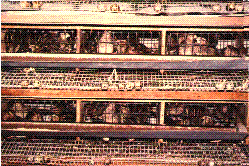 The system of housing depends very much on the type and scale of the quail enterprise. Most commercial quail farmers in Singapore will use a cage system. They build their cages inside closed houses with wire mesh surrounding both sides of the house for well ventilation. A concrete floor is essential, and the building needs to be substantial enough, not only to deter rodents and other pests but also to provide drought-free and well-ventilated, sheltered accommodation. Canvas-cloth is sometime hanged over on both sides of the house is prevent direct sunlight into the cages. The quails are never exposed to direct sunlight.
The system of housing depends very much on the type and scale of the quail enterprise. Most commercial quail farmers in Singapore will use a cage system. They build their cages inside closed houses with wire mesh surrounding both sides of the house for well ventilation. A concrete floor is essential, and the building needs to be substantial enough, not only to deter rodents and other pests but also to provide drought-free and well-ventilated, sheltered accommodation. Canvas-cloth is sometime hanged over on both sides of the house is prevent direct sunlight into the cages. The quails are never exposed to direct sunlight.
The farmers use 6 tier high cages which indicates how little head room this quail requires. Each unit is about 6 feet in length and 1 foot in width, and subdivided into 6 subunits. The farmers use very little metal in their cages. The birds stand on sloping slatted wooden floors. The droppings fall into pull-out wooden trays. Front and rear of cages are closed by wooden slats. Long narrow feed troughs are placed in front of the cages and PPC water troughs are placed at the back of the cages. The eggs roll out under the feed troughs and are collected twice daily, once in the morning and once in the evening. Commercial egg layers are usually housed in colonies of 10-12 birds per cage. For breeding purposes, male quails are introduced in the cages i n the ratio of 1 to 3 females.
Lighting For Laying Quail
From experiment it has been proved that light has more importance than temperature in stimulating hens to lay. One report indicates the bird will lay to zero temperature if the light of day is extended to at least 14 hours.
A bright light is not necessary. Just enough to maintain wakefulness and social activity in the flock is sufficient. Electric bulbs of 40 or 60 watts may be used in colony pens.
For the light to be effective it must be turned on before dark and calculated to go off after the day has been extended to 14 or 16 hours. Control of the light may be by a time switch. Singapore quail farmers always leave the light on continuously during the night, and there is indication that hens may lay just as well if the light is left on all the time.


